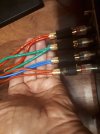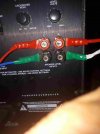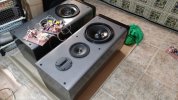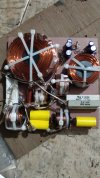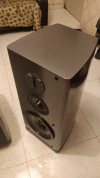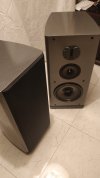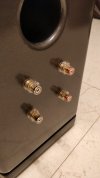After a hiatus from 1988 to 2009 I gingerly rejoined the Hi-Fi scene.
First I got a cheap 20W AB class amplifier built by a friend and picked up an used Phillips HiQ speaker pair.
Then I attended a couple of Pune chapter meetings, of the forum, to listen to various Hi-Fi gear.
And from 2011 I started auditioning amplifiers and speakers. I had almost finalised on the HK3390+JBLES80 amp speaker combo. But a series of family medical emergencies put paid to all these plans.
Fast forward to 2019 end. The amplifier stated giving up – mainly noise in the volume pot. And most of our listening was from online sources on the mobile. I could not connect the headphone out of the mobiles to the line in of the amplifier due to impedance mismatch.
In March 2020 Covid19 struck and put paid to my initial efforts to look for replacements. In early July, just on a wild impulse & egged on by VenkatCR, I ordered a Denon PMA600NE amplifier from Hifimart.
I was clear that I needed a speaker made to suit my requirements. I conveyed my requirements to Sandeep Devasthali of SMD Audio:-
Project: 2/3 way floor standing speaker prototyping.
1. Current setup:
Denon PMA600-NE amplifier & Phillips HiQ speakers. Iball desktop woofer used to reinforce lowest frequencies.
Denon amplifier is rated at 45w into 8 ohms and 70w into 4 ohms. It has frequency response of 5Hz-100Kz. Treble control at 10kHz +/-8dB. Bass control at 100Hz+/- 8dB.
Amplifier has single subwoofer line out that is filtered to 100Hz.
Amplifier has line out (marked as recorder out).
Listening position at 8-10 feet from speakers. Listening volume 55-70 dB at the position.
Music genres: Indian classical, Film songs, Western classical, Jazz, and other light music.
Issue with current setup:-
Speakers are old. They have excellent clarity, but soundstage and instrument separation is lacking.
Room is large – 12’x16’. But there are cupboards, doors and windows that affect the sound. Also we do not sit at the exact sweet spot and tend to move around a bit.
Approx height of ears while seated on couch is between 40-48”.
Approx height of ears while seated on floor is between 24-28”.
Approx height of ears while standing is between 60-64”.
2. Requirements:-
i) Floorstanding speakers. Selection of drivers and crossover points to be determined in prototype build. One single prototype build can be done as a bookshelf if that is convenient.
Ideally crossover should be at 100Hz and other crossover should be above 2000-2500 Hz.
ii) Main requirements are clarity of music, soundstage and instrument separation. All this to be achieved for low listening volumes, 55-70 dB, as described above.
iii) Low bass(below 100Hz) is required more for reinforcing low music notes and harmonics of such bass instruments. Floor thumping effect, as in Home theatre, is not required.
For frequencies below 100Hz an additional class D amplifier can be considered if it is felt that the Denon will fall short. How to wire the inputs to this amp will have to be considered.
iv) The system can be setup as 2 floorstanders with 1 separate subwoofer. Or 2 subwoofers integrated into the floorstander structure.
v) Depending on the drivers selection the speaker would be either 2 way in main speaker+subwoofer or 3 way main or 3 way main+subwoofer.
vi) Design layout can be classical inline drivers or MTM type.
vii) There is no urgency for the build. So suitable time can be taken for design and prototype.
viii) Please keep in mind low listening Db. So we may need to re-examine all conventional wisdom of speaker driver selections and layouts.
I had identified the Hivi Rt1C-A tweeter (Isodynamic Planar Tweeter) for the build. And one thing I was insisting on was that the main speaker should not go below 100Hz.
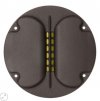
After some discussions this was the final configuration that was finalised:-
Design... 3 way 3 drivers Floorstanding satellites.
Enclosure.....Sealed box. Fully chambered and braced internally with cross ladder design. Sandwich front and back baffle (36mm thick each side). Near resonance free construction. Separate enclosures for both midrange and tweeter. No Porting.
LF driver... Specially manufactured (for SMD Audio)135mm Titanium injected PP cone Woofers.
Midrange......88mm titanium injected PP cone
HF driver..... HiVi Rt1C-A (Planar Isodynamic tweeter)
Crossover Type and order..... 24 db/Oct (4th order) with dual bandpass for woofer and Midrange. Lpad for HF.
Crossover frequencies.. 100Hz/500Hz/4000Hz
Power handling.... 80 watts RMS min.
Nom Impedance.... 4 ohms
Speaker connector terminals.... Press-fit, Goldplated, Bi ampable/wireable. Can accommodate upto 10 AWG speaker cable.
Damping material.... Polyfil
Cables used 1.5sq mm pure OFC.
Separate thick and heavy base with adjustable brass spikes for min contact with floor.
Weight per tower... Approximately 14kg
Subwoofer: 100 watts RMS high power Class AB active type with EI transformer power supply. Provision for speaker level inputs as also LF signals from the amplifier. The crossover on the subwoofer is 12db/Oct (2nd order) variable upto max 200Hz. Dual 138mm drivers with inverted placement design as an Acousticmass type. Front ported.
The calculated sensitivity was 91dB/1W/1m. Impedance is 4 ohms.
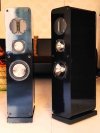
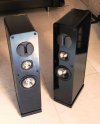 Final order was placed in the first week of September and I took delivery on 8th. October.
Final order was placed in the first week of September and I took delivery on 8th. October.
Covid19 had put paid all my plans to audition various speakers. I had taken a big gamble by insisting on the HiVi tweeter. So, continuing in the same vein, I decided to to do a remote audition of this finished speaker.
Sandeep sent some videos of the speaker playing a few of my test tracks. Based on his feedback, and my hearing the videos, I was satisfied and asked him to pack the speakers. I picked them up by car.
Total cost for the 2.1 system came to a shade over Rs. 77K. including taxes.
I have used the speaker for more than 70 hrs. The speaker is setup as a 2.1 system with the subwoofer using a pair of speaker level connections. The wiring is done using Klotz LY225T cables(2.5mm sq OFC) with gold plated banana plugs and gold plated spade connectors. And I am happy to report that my gamble has paid off, thanks to the excellent design and manufacturing done by Sandeep.
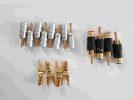
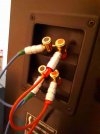
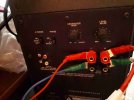
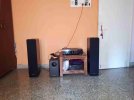
1. MUSICALITY & LISTENING
The tweeter selection was a shot in the dark. I liked the specs and the fact that it had limited vertical spread and a very wide horizontal spread. And some online reviews had talked of the smoothness and soundstage.
I had some reservations of a crossover at 500Hz as it is bang in the midrange. But Sandeep was confident and he has really pulled it off.
Sandeep’s selection of drivers, considering the constraints of the tweeter, is perfect. I gather he gets them custom made from IWAI.
The speaker box is built like a tank. It really feels solid to the knuckle rap test. There is absolutely no resonance. Also the heavy plinth construction ensures that there is very little vibration transferred to and from the floor.
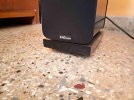
He had to split the crossover board into 2 to fit into the narrow width. This has helped in avoiding any cross induction (magnetic coupling) between the large coils (especially the woofer network). As the tweeter was 5 dB more sensitive than the other drivers he had to use a L-Pad design to damp it down. And air-core inductors all round to ensure a stable performance. The crossover boards are really massive.!!
The subwoofer is a standard design that is manufactured and stocked by Sandeep. So it was basically off the shelf.
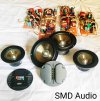
The sound spectrum frequency response is seamless with no dips or peaks anywhere in listening tests. Also the speakers sound extremely neutral and do not lend any colouration. And having a separate subwoofer with adjustable amplification has helped in getting the correct level of sub-bass reinforcement without drowning out the mid-bass, midrange and low treble.
We generally sit on a sofa at the very end of the room, which is not the sweet spot for these speakers. The speakers are not toed in. And they are pulled out only 1 foot from the wall. The subwoofer is placed roughly in the middle of the two speakers. All listening is at 55-65 dB 12 feet from the speaker front. The sweet spot is approximately 6 feet from the speakers.
Most of the music is from YouTube or Spotify Pro cast from mobile to the Denon by bluetooth 4.2. In-spite of this suboptimal listening setup I am getting very good results as explained in further points. BTW I have also heard my test tracks sitting in the sweet spot. The improvement is only marginal as far as music quality is concerned but soundstage does improve a lot.. I have also played these test tracks as FLAC files through a RPI+AlloBoss DAC setup. Again the difference is marginal. Similarly i have used the RPI+AlloBoss DAC setup as a Spotify connect node to play back tracks. Improvement is marginal.
I have also got some 192Khz/24Bit tracks from Acoustic Portrait. These are classical Hindustani & Carnatic instrumentals. The speakers performed effortlessly.
2. SOUNDSTAGE & IMAGING
In a nutshell - the soundstage is wiiidee. And imaging is totally 3-dimensional. The subwoofer totally disappears. And the same happens to the main speakers for well recorded tracks.
In orchestral music one can easily make out individual instruments and locate them in both width and depth. A particular point that I noticed is that reverbs of bass instruments have the decay progressing in both depth and height.
Also the spread of music is such is that there is no reflections off the ceilings and floor or from the side wall or cupboards.
For really well mastered tracks I have heard the soundstage extend way beyond the main speakers.
If I could pull the speakers out further from the wall the depth of the stage would improve. But that is not feasible.
3. DYNAMICS & HARMONICS.
The tweeter goes up to 40KHz, with frequencies above 30KHz showing a 6-10 dB dip in the graphs. Now I am 62 years old and can’t hear beyond 15KHz on most days. But I could still feel the improvement in the upper frequencies of all the music I heard.
The subwoofer, at 50% volume setting, goes down easily to 35 Hz. This LF extension lends a wonderful body and strength to the mid bass and lower midrange frequencies. This is normally lacking on most entry level floorstanders. And all the time the midrange has full body and detail.
Complex passages having harmonics of drums, strings and vocals at the same time are reproduced simultaneously with one able to pick up the individual streams. And I never felt that the speaker was slow to respond or too fast at any time.
The crossover design is perfect. I could not make out any transits or dips that could be attributed to the crossovers. I have set the crossover on the subwoofer at 100Hz. As it is a second order design there is a good overlap with the LF driver. So one cannot make out the transfer point. And it also helps in making the subwoofer disappear.
4. FINAL THOUGHTS
The speaker effortlessly handles complex and difficult music. This includes 24/192 FLAC files, DSD 226, MQA and even well recorded MP3.
As it is a high efficiency speaker i am able to drive them with the amplifier at 9 o'clock volume position. So it has a lot of spare headroom for any difficult passages or higher volume listening.
Any upgrade will first have to be to acquire lots of well recorded and mastered tracks.
Possibly the next upgrade would call for a very high end DAC. But the cost benefit ratio does not seem very appealing.
5. MUSIC TRACKS USED FOR TRIALS
Scarboroug Fair – Simon & Garfunkel
Hotel California – Eagles
Keith Don’t Go- Nils Lofgren
Summer Wine- Nancy Sinatra
The Dance of Envy – Instrumental -Uttam Singh
1812 Overture Finale – London Symphony Orchestra
The Humma Song – AR Rehman
Carmin Burana – Carl Orf
Shri Krishna Flute – 8D
Breathless – Shankar Mahadevan
The Lonely Shepard – Andree Rieu
For a few Dollars more – Main Theme
Dil Toh Pagal hai – Lata Mangeshkar
Saathia – Full album
Chariots of Fire - Vangelis
Raag Ahir Bairavi – shenai recorded & mastered in 24Bit 192KHz by Acoustic portrait
Naad Naman - recorded & mastered in 24Bit 192KHz by Acoustic portrait
Frank Bridge Variations - Romance Trondheimsolistene – 128 & 256 DSD
SwaraZankar online streamed music concerts.
Various YouTube streams of concerts.
First I got a cheap 20W AB class amplifier built by a friend and picked up an used Phillips HiQ speaker pair.
Then I attended a couple of Pune chapter meetings, of the forum, to listen to various Hi-Fi gear.
And from 2011 I started auditioning amplifiers and speakers. I had almost finalised on the HK3390+JBLES80 amp speaker combo. But a series of family medical emergencies put paid to all these plans.
Fast forward to 2019 end. The amplifier stated giving up – mainly noise in the volume pot. And most of our listening was from online sources on the mobile. I could not connect the headphone out of the mobiles to the line in of the amplifier due to impedance mismatch.
In March 2020 Covid19 struck and put paid to my initial efforts to look for replacements. In early July, just on a wild impulse & egged on by VenkatCR, I ordered a Denon PMA600NE amplifier from Hifimart.
I was clear that I needed a speaker made to suit my requirements. I conveyed my requirements to Sandeep Devasthali of SMD Audio:-
Project: 2/3 way floor standing speaker prototyping.
1. Current setup:
Denon PMA600-NE amplifier & Phillips HiQ speakers. Iball desktop woofer used to reinforce lowest frequencies.
Denon amplifier is rated at 45w into 8 ohms and 70w into 4 ohms. It has frequency response of 5Hz-100Kz. Treble control at 10kHz +/-8dB. Bass control at 100Hz+/- 8dB.
Amplifier has single subwoofer line out that is filtered to 100Hz.
Amplifier has line out (marked as recorder out).
Listening position at 8-10 feet from speakers. Listening volume 55-70 dB at the position.
Music genres: Indian classical, Film songs, Western classical, Jazz, and other light music.
Issue with current setup:-
Speakers are old. They have excellent clarity, but soundstage and instrument separation is lacking.
Room is large – 12’x16’. But there are cupboards, doors and windows that affect the sound. Also we do not sit at the exact sweet spot and tend to move around a bit.
Approx height of ears while seated on couch is between 40-48”.
Approx height of ears while seated on floor is between 24-28”.
Approx height of ears while standing is between 60-64”.
2. Requirements:-
i) Floorstanding speakers. Selection of drivers and crossover points to be determined in prototype build. One single prototype build can be done as a bookshelf if that is convenient.
Ideally crossover should be at 100Hz and other crossover should be above 2000-2500 Hz.
ii) Main requirements are clarity of music, soundstage and instrument separation. All this to be achieved for low listening volumes, 55-70 dB, as described above.
iii) Low bass(below 100Hz) is required more for reinforcing low music notes and harmonics of such bass instruments. Floor thumping effect, as in Home theatre, is not required.
For frequencies below 100Hz an additional class D amplifier can be considered if it is felt that the Denon will fall short. How to wire the inputs to this amp will have to be considered.
iv) The system can be setup as 2 floorstanders with 1 separate subwoofer. Or 2 subwoofers integrated into the floorstander structure.
v) Depending on the drivers selection the speaker would be either 2 way in main speaker+subwoofer or 3 way main or 3 way main+subwoofer.
vi) Design layout can be classical inline drivers or MTM type.
vii) There is no urgency for the build. So suitable time can be taken for design and prototype.
viii) Please keep in mind low listening Db. So we may need to re-examine all conventional wisdom of speaker driver selections and layouts.
I had identified the Hivi Rt1C-A tweeter (Isodynamic Planar Tweeter) for the build. And one thing I was insisting on was that the main speaker should not go below 100Hz.

After some discussions this was the final configuration that was finalised:-
Design... 3 way 3 drivers Floorstanding satellites.
Enclosure.....Sealed box. Fully chambered and braced internally with cross ladder design. Sandwich front and back baffle (36mm thick each side). Near resonance free construction. Separate enclosures for both midrange and tweeter. No Porting.
LF driver... Specially manufactured (for SMD Audio)135mm Titanium injected PP cone Woofers.
Midrange......88mm titanium injected PP cone
HF driver..... HiVi Rt1C-A (Planar Isodynamic tweeter)
Crossover Type and order..... 24 db/Oct (4th order) with dual bandpass for woofer and Midrange. Lpad for HF.
Crossover frequencies.. 100Hz/500Hz/4000Hz
Power handling.... 80 watts RMS min.
Nom Impedance.... 4 ohms
Speaker connector terminals.... Press-fit, Goldplated, Bi ampable/wireable. Can accommodate upto 10 AWG speaker cable.
Damping material.... Polyfil
Cables used 1.5sq mm pure OFC.
Separate thick and heavy base with adjustable brass spikes for min contact with floor.
Weight per tower... Approximately 14kg
Subwoofer: 100 watts RMS high power Class AB active type with EI transformer power supply. Provision for speaker level inputs as also LF signals from the amplifier. The crossover on the subwoofer is 12db/Oct (2nd order) variable upto max 200Hz. Dual 138mm drivers with inverted placement design as an Acousticmass type. Front ported.
The calculated sensitivity was 91dB/1W/1m. Impedance is 4 ohms.

 Final order was placed in the first week of September and I took delivery on 8th. October.
Final order was placed in the first week of September and I took delivery on 8th. October.Covid19 had put paid all my plans to audition various speakers. I had taken a big gamble by insisting on the HiVi tweeter. So, continuing in the same vein, I decided to to do a remote audition of this finished speaker.
Sandeep sent some videos of the speaker playing a few of my test tracks. Based on his feedback, and my hearing the videos, I was satisfied and asked him to pack the speakers. I picked them up by car.
Total cost for the 2.1 system came to a shade over Rs. 77K. including taxes.
I have used the speaker for more than 70 hrs. The speaker is setup as a 2.1 system with the subwoofer using a pair of speaker level connections. The wiring is done using Klotz LY225T cables(2.5mm sq OFC) with gold plated banana plugs and gold plated spade connectors. And I am happy to report that my gamble has paid off, thanks to the excellent design and manufacturing done by Sandeep.




1. MUSICALITY & LISTENING
The tweeter selection was a shot in the dark. I liked the specs and the fact that it had limited vertical spread and a very wide horizontal spread. And some online reviews had talked of the smoothness and soundstage.
I had some reservations of a crossover at 500Hz as it is bang in the midrange. But Sandeep was confident and he has really pulled it off.
Sandeep’s selection of drivers, considering the constraints of the tweeter, is perfect. I gather he gets them custom made from IWAI.
The speaker box is built like a tank. It really feels solid to the knuckle rap test. There is absolutely no resonance. Also the heavy plinth construction ensures that there is very little vibration transferred to and from the floor.

He had to split the crossover board into 2 to fit into the narrow width. This has helped in avoiding any cross induction (magnetic coupling) between the large coils (especially the woofer network). As the tweeter was 5 dB more sensitive than the other drivers he had to use a L-Pad design to damp it down. And air-core inductors all round to ensure a stable performance. The crossover boards are really massive.!!
The subwoofer is a standard design that is manufactured and stocked by Sandeep. So it was basically off the shelf.

The sound spectrum frequency response is seamless with no dips or peaks anywhere in listening tests. Also the speakers sound extremely neutral and do not lend any colouration. And having a separate subwoofer with adjustable amplification has helped in getting the correct level of sub-bass reinforcement without drowning out the mid-bass, midrange and low treble.
We generally sit on a sofa at the very end of the room, which is not the sweet spot for these speakers. The speakers are not toed in. And they are pulled out only 1 foot from the wall. The subwoofer is placed roughly in the middle of the two speakers. All listening is at 55-65 dB 12 feet from the speaker front. The sweet spot is approximately 6 feet from the speakers.
Most of the music is from YouTube or Spotify Pro cast from mobile to the Denon by bluetooth 4.2. In-spite of this suboptimal listening setup I am getting very good results as explained in further points. BTW I have also heard my test tracks sitting in the sweet spot. The improvement is only marginal as far as music quality is concerned but soundstage does improve a lot.. I have also played these test tracks as FLAC files through a RPI+AlloBoss DAC setup. Again the difference is marginal. Similarly i have used the RPI+AlloBoss DAC setup as a Spotify connect node to play back tracks. Improvement is marginal.
I have also got some 192Khz/24Bit tracks from Acoustic Portrait. These are classical Hindustani & Carnatic instrumentals. The speakers performed effortlessly.
2. SOUNDSTAGE & IMAGING
In a nutshell - the soundstage is wiiidee. And imaging is totally 3-dimensional. The subwoofer totally disappears. And the same happens to the main speakers for well recorded tracks.
In orchestral music one can easily make out individual instruments and locate them in both width and depth. A particular point that I noticed is that reverbs of bass instruments have the decay progressing in both depth and height.
Also the spread of music is such is that there is no reflections off the ceilings and floor or from the side wall or cupboards.
For really well mastered tracks I have heard the soundstage extend way beyond the main speakers.
If I could pull the speakers out further from the wall the depth of the stage would improve. But that is not feasible.
3. DYNAMICS & HARMONICS.
The tweeter goes up to 40KHz, with frequencies above 30KHz showing a 6-10 dB dip in the graphs. Now I am 62 years old and can’t hear beyond 15KHz on most days. But I could still feel the improvement in the upper frequencies of all the music I heard.
The subwoofer, at 50% volume setting, goes down easily to 35 Hz. This LF extension lends a wonderful body and strength to the mid bass and lower midrange frequencies. This is normally lacking on most entry level floorstanders. And all the time the midrange has full body and detail.
Complex passages having harmonics of drums, strings and vocals at the same time are reproduced simultaneously with one able to pick up the individual streams. And I never felt that the speaker was slow to respond or too fast at any time.
The crossover design is perfect. I could not make out any transits or dips that could be attributed to the crossovers. I have set the crossover on the subwoofer at 100Hz. As it is a second order design there is a good overlap with the LF driver. So one cannot make out the transfer point. And it also helps in making the subwoofer disappear.
4. FINAL THOUGHTS
The speaker effortlessly handles complex and difficult music. This includes 24/192 FLAC files, DSD 226, MQA and even well recorded MP3.
As it is a high efficiency speaker i am able to drive them with the amplifier at 9 o'clock volume position. So it has a lot of spare headroom for any difficult passages or higher volume listening.
Any upgrade will first have to be to acquire lots of well recorded and mastered tracks.
Possibly the next upgrade would call for a very high end DAC. But the cost benefit ratio does not seem very appealing.
5. MUSIC TRACKS USED FOR TRIALS
Scarboroug Fair – Simon & Garfunkel
Hotel California – Eagles
Keith Don’t Go- Nils Lofgren
Summer Wine- Nancy Sinatra
The Dance of Envy – Instrumental -Uttam Singh
1812 Overture Finale – London Symphony Orchestra
The Humma Song – AR Rehman
Carmin Burana – Carl Orf
Shri Krishna Flute – 8D
Breathless – Shankar Mahadevan
The Lonely Shepard – Andree Rieu
For a few Dollars more – Main Theme
Dil Toh Pagal hai – Lata Mangeshkar
Saathia – Full album
Chariots of Fire - Vangelis
Raag Ahir Bairavi – shenai recorded & mastered in 24Bit 192KHz by Acoustic portrait
Naad Naman - recorded & mastered in 24Bit 192KHz by Acoustic portrait
Frank Bridge Variations - Romance Trondheimsolistene – 128 & 256 DSD
SwaraZankar online streamed music concerts.
Various YouTube streams of concerts.


